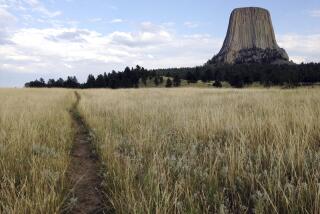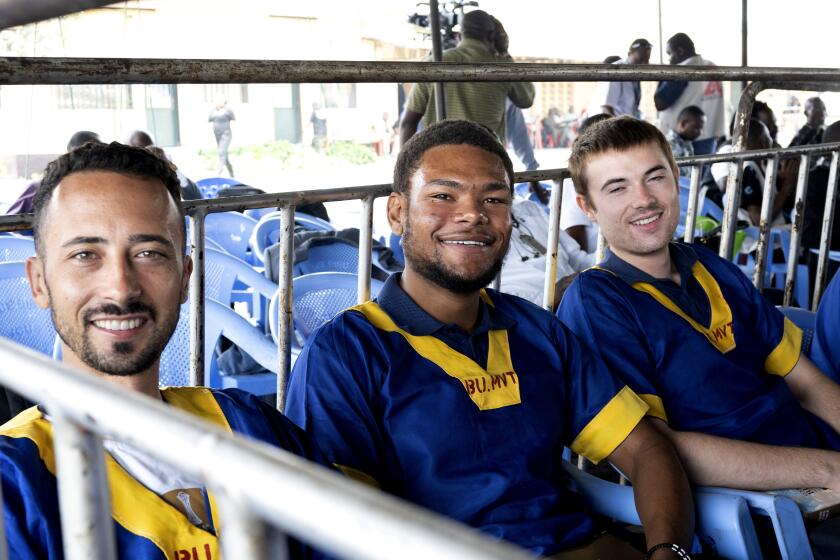Burial Plot May Hold Clues to Greece’s Mystery Era
In a cramped burial ground, two abbreviated lives shared a single grave. A baby’s slender bones lay cradled in the pelvis of his young mother, who died during childbirth.
For American archeologists exploring the site, the most tantalizing question may still be yielded by the mournful remains: Who was the father? Or, to be more precise, where did he come from?
The excavation of the grave site, which is nearing completion, shows promise of filling in many blanks about the conquest of southern Greece by northern European Franks in the 13th century--one of the least-chronicled periods in the region’s multilayered history.
Much of Greece was entering an age shadowed between two major epochs: the Christian Orthodox Byzantine Empire and the four-century Muslim occupation under the Ottoman Empire, which ended in the 1820s.
“It’s a pivotal time,” said Charles Williams II, who is leading the archeological team backed by the American School of Classical Studies in Athens. “We have here the Latin West meeting the Greek East.”
To what degree the two cultures, churches and traditions mixed is the overarching quest of the dig in Ancient Corinth, about 40 miles west of Athens. Analyses of bones, pottery shards and other objects may offer a clearer sense of how much intermarriage and interplay occurred during the first major contact between Europeans moving into the Golden Age and heartland Greeks left adrift by the splintering of the Byzantine Empire.
For example, are the remains in the graves both Franks and Greeks? Could the babies buried there be among the first products of a mixing of medieval blood?
The outcome of the research is particularly compelling for modern Greeks, who may occupy the same land as Aristotle and Pericles but share a much less direct genetic link.
Centuries of invasion, occupation and trade have left a smeared palette of backgrounds and bloodlines. Evidence of extensive domestic relationships during the Frankish period would help add another bit of clarity to the backgrounds of the present-day Greeks.
“Greece has always been a crossroads of the world, and Corinth has always been the crossroads of Greece,” Williams said. “We are working on a very complex cultural and ethnic puzzle.”
The Franks--occupying what is now France, Belgium and much of central Europe--arrived in southern Greece early in the 13th century on the Fourth Crusade. The legions were diverted by their powerful Venetian financial backers to sack Constantinople, the Byzantine capital and the center of Christian Orthodoxy.
Corinth--once a regional hub of the Roman Empire--became a key outpost for the Franks in Morea, the hand-shaped peninsula now called Peloponnesus.
Under the rocky peak of the ancient Acrocorinth citadel, the Franks quickly rooted their traditions. A wide avenue was built for European-style street fairs and parades. Livestock was raised to satisfy the Franks’ taste for meat. Wine was consumed straight, baffling the Greeks, who preferred it cut with honey and sometimes a bit of seawater.
Excavations of homes and stores point toward some Greek acceptance of the new ways, Williams said. The Greeks, however, generally refused to accept the Latin-rite Christianity brought by the crusaders.
“The land still belongs to us,” said Jose Perez. “We would like to see justice done, to have the wrongs that were done righted.”
The grave-site dig could provide an insightful catalog of life in southern Greece during the Middle Ages, archeologists say.
The cemetery, built over the ruins of a Byzantine monastery, appears to have been associated with an infirmary or hospice. More than 100 bodies were interred in the 13- by 13-foot area. Infants and small children were buried along one wall.
“The location of the grave site would suggest the people were from the Frankish community,” said archeologist Arthur Rohn, dusting around the jaw bone of a man’s skeleton. “But not everything fits this mold. Is this a mixed group? How much did the communities overlap? These are the type of questions we are asking.”
The adult bodies, for example, were placed in Byzantine style: head propped up facing east and disturbed bones from earlier graves piled at the feet. Shards also suggest the Byzantine tradition of burning lamps on grave sites.
Rohn and his colleague at Wichita State University, Ethne Barnes, plan to begin analysis of some of the remains this summer to look for ethnic origins.
Bone studies may help bring back some stories. These could be signs of battle marks--possibly a crusader--or stress fractures or calcium deposits from the hard life of a feudal serf.
“This place has a fascinating story to tell,” Barnes said. “We’re trying to hear it.”
More to Read
Sign up for Essential California
The most important California stories and recommendations in your inbox every morning.
You may occasionally receive promotional content from the Los Angeles Times.










